In Part 1, we laid out the context for the emergence of the new wave of ecommerce enablers in Indonesia. And now in this article, with that context in mind, we tackle the various strategies some of these enablers have taken to (1) go to market and acquire a foundational base of users and assets (data, distribution) and (2) drive retention and creating long-term value for their industry or target market segments.
Highlights
- Second-wave enablers are introducing ecommerce into certain industries, value chains, and SKUs, rather than the other way.
- Given the challenges of introducing tech to offline merchants, long-term adoption involves integrating seamlessly and progressively into existing operations of the business and becoming indispensable in the continued growth of the business.
- Second-wave enablers are not necessarily confined to enablers that start out enabling transactions but even second-order enablers are more focused on other operations involved in growing ecommerce businesses.
- Winning the trust of their target customers to keep using their solutions, creating strong feedback loops within the product to build up a treasure trove of data, and leveraging both data analytics and trust to establish distribution that customers are also able to benefit from are key highlights of second wave enabler GTM strategies.
- With trust, data, and distribution in the bag, these enablers then have the tools to progressively unlock a full-stack operating system (OS) that becomes ubiquitous for their customers, either across functions or across use cases.
- The principle behind this is if the transactions and operations of customers are improved, the industry grows with more volume, distribution (e.g. exports), and players, and this ultimately benefits the enabler as well.
- The learnings in Part 2 can apply to businesses anywhere, and we see this as well in other B2B SaaS companies as well as ecommerce enablers in other Southeast Asian markets.
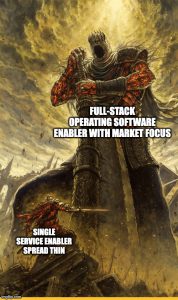
But before we dive into these strategies a few more insights into the context in which these startups operate, i.e. the difference between the first wave and second wave ecommerce enablers. These insights will explain in better depth the stronger motivation for the growth trajectories of these business models.
First, while first wave ecommerce enablers came as a result of ecommerce marketplaces, second wave ecommerce enablers are not as dependent on existing ecommerce marketplaces, and in fact, are emerging in industries that existing generalist ecommerce marketplaces have been unable to unlock (going back to the idea of counter-position companies).
In a way, second-wave enablers are introducing ecommerce into certain industries, value chains, and SKUs, rather than the other way. The opportunity for this to happen in Indonesia is relatively large given the size of the offline market for many industries.
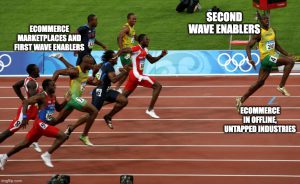
Second is that because second-wave enablers are building towards full-stack enablement, long-term adoption involves “integrating” seamlessly into existing operations of the business and becoming indispensable in the continued growth of the business, as opposed to first-wave enablers where these tools could be a lot more auxiliary on their own or easily replaceable. Again this emphasizes the importance for these second-wave enablers to tie their success to the success of their customers. It also points toward the inherent challenges of introducing these digital tools to merchants that until recently have not really considered using these types of solutions.
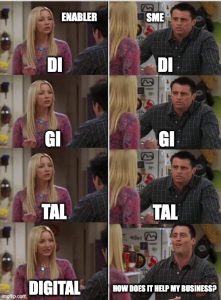
Finally, second-wave enablers are not necessarily confined to enablers that start out enabling transactions but even second-order enablers are more focused on other operations involved in growing ecommerce businesses, from open banking APIs to credit scoring tools in fintech and from warehouse management software to order management software in logistics. Again, as these second-order enablers expand, it is possible they may grow to become closer to the transactions they are enabling, and so the lines are blurring in this way as well. This points to Indonesia’s increasingly maturing and complex competitive landscape, where competition is not happening across single products but in multiple areas.
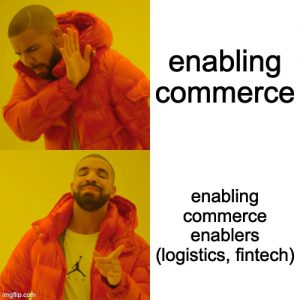
Go-To-Market: Building Trust, Data, and Distribution
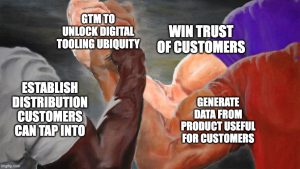
Go-To-Market strategies for these second-wave enablers are less centered on purely enabling supply and demand volume acquisition. That is usually just the first step in a bigger picture.
(1) Winning the trust of their target customers to keep using their solutions (as the idea is to introduce an entire stack of them), (2) creating strong feedback loops within the product to build up a treasure trove of data, and (3) leveraging both data analytics and trust to establish distribution that customers are also able to benefit from in planning and managing operations and transactions are key highlights of these GTM strategies.
The idea behind prioritizing trust, data, then distribution is to be able to generate early but (1) sustainable success for customers while also laying the groundwork to later on introduce more value propositions, (2) win even more customers down the road with key players in the value chain already using that enabler in their operations, and (3) build a strong moat through distribution early on.
The way these three elements are built up will then differ depending on the focus of the business, in terms of their (1) core value proposition and the (2) target market this value proposition is for.
Technology-Focused GTM for a Second-Order Ecommerce Enabler
In the case of Verihubs, we see that their stack of verification solutions were developed on top of in-house artificial intelligence expertise. Considering this core value proposition of providing best-in-class AI-based verification tech to integrate in existing business applications and processes, the way trust is built in these tech-based value propositions is usually through finding the biggest, low-hanging fruits. For Verihubs, these were established banks, financial institutions, or even sizable fintechs like Payfazz in rural Indonesia where the needs for verification have been more pressing.
As CEO Rick Firnando explains on our podcast, “The reason why we decided to put our attention to banks and financial institutions is first, they happen to have the same unsolved pain, which is a lack of onboarding process automation. Typically before using us, the onboarding process would take weeks, but with us, the process only takes five seconds and basically this also enables them to defend their customers from fraud activities. And we believe AI is just a starting point to effectively prevent this from happening…
…The way we tackle these challenges [of building trust] was we made sure our product solves our customer’s problems. This is the first one, and we really paid attention to our product reliability because [we’re] in B2B market sales; your product has to be reliable. And the last one was getting their credibility, which is why we dealt with banks and fintechs in the first place. Having big banks as our customers definitely will help us to get more customers because everyone knows earning trust from banks is not that easy.”
After gaining trust with early successes, Verihubs could then more easily build up their data trove by acquiring customers with their existing track record and brand record. Beyond having a deeper understanding of the market through this data, when it comes to AI, data is also important to making their solution smarter and capable of “learning” new use cases.
Then with this data and trust, they could think about building up customer distribution in two directions. First is looking at what other financial services they could enable having won over early customers in the financial and banking sector.
Rick outlines this on our podcast, “First one would be the verification. The second one would be the open banking solutions. So open banking is quite broad. It can be used for many use cases, like to streamline the loan process and many others, and the third one we believe that it’s [about] connecting the data. We’re doing verification. We’re doing open banking. Obviously we are [also] getting a lot of data and building and connecting the data [to] build products that can be beneficial or FinTech is what we’re looking for. One of them is basically credit scoring.”
The second would be looking at what other sectors they could tap into with their existing solutions.
“Currently we actually have a very high demand from the marketplace. They want to verify the users and merchants. And also some unique use cases with our existing clients for rental marketplace, hotel staff, workforce service platform, and digital agent applications. We believe that our verification solutions are applicable to many use cases because every platform, including mobile apps or websites will need reliable verification [technology].”
While Verihubs is not directly or solely powering ecommerce businesses per se, their technology is enabling first order enablers to unlock value more efficiently for customers who are actually making these commerce transactions.
Value Chain Segment-Focused GTM for a First-Order Ecommerce Enabler
We also see this trust-data-distribution domino effect exist with more of a value chain focus. Just like the starting point for the technology focus is to find big, low-hanging fruit, the starting point for the value chain focus is to also to find the low cost (with respect to acquisition) but high demand (with respect to the value proposition) segment to digitally enable first.
And typically these businesses with a value chain focus are first-order enablers operating in industries without existing massive marketplaces, meaning they would start with bringing in volume more efficiently for this segment.
For Wifkain, by connecting upstream and downstream players through better facilitation of transactions on their textile trading marketplace, they are able to not only to win the trust of these players by securing them volume, but also build up data for demand analysis and forecasting.
This data analytics ultimately helps reduce inventory risk and optimize sales volume for their customer merchants. The data also provides the groundwork for other services down the road. Finally, with all these textile merchants and factories using their marketplace and benefiting from the data, Wifkain is able to create owned distribution right in the middle of the industry’s value chain.
As Wifkain CEO Sara Sofyan explains on the podcast, “The focus will be to integrate and connect the upstream and also the downstream side. I think digital is key. It must be the key to creating this [holistic] ecosystem, and also once they get connected, it will present a lot of data, a lot of data such as demand analysis, and demand forecasting, so the merchants can actually produce the right fabrics.”
“So [the data] really helps them in terms of inventory risk and also optimize sales volume from the consumer side, so they can actually get a lot of cheaper products and they can actually sell very competitively, and also, it helps them get a really fast SLA to procure and hence they can restock things very fast and optimize their sales revenue there as well.”
Ubiquity-Driven Pathway to Full Stack OS that Grows Industries
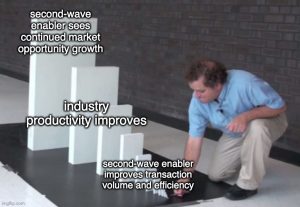
With trust, data, and distribution in the bag, these enablers then have the tools to progressively unlock a full-stack operating system (OS) that becomes ubiquitous for their customers, either across functions or across use cases. It’s important to note the word “progressively” here, given that especially in Indonesia, many of the target customers of these enablers are often digitizing for the first time, or making the switch from legacy systems (e.g. Excel) to more customized solutions. The progression of this full-stack OS development is best tied to how the customers of the enabler are themselves growing and the new pain points that evolve.
The point of building an OS for the enabler’s target segment is not just to build an OS but to build a sustainable way to ensure transactions and operations of their target businesses continue to run efficiently. The principle behind this is if the transactions and operations of customers are improved, the industry grows with more volume, distribution (e.g. exports), and players, and this ultimately benefits the enabler as well. In the short-term, this also works towards improving retention through adjacent services and lowering acquisition costs.
It’s essentially all about engineering a self-fulling prophecy — the vision for many of these enablers is to grow the industries they are in or market segments they are targeting, and by building for the industry and segment’s entire needs rather than any specific pain point, they are increasing the chances for this vision to be achieved.
The Case of Finding Focus Through Retention
In the case of CrediBook, they started out as a bookkeeping app enabling merchants to better manage their cash flow and SKUs, but with the launch of CrediMart in 2021, began to focus more specifically on enabling transactions and operations management for the wholesaler segment and now building the operating software for wholesalers in Indonesia.
This trajectory is interesting compared to the ones we’ve discussed previously because compared to picking a specific value chain segment from the get-go, CrediBook cast a wide net with their bookkeeping app then discovered the wholesaler pain point amidst their growing user base of SME business owners.
That said, it still applies the principle of “progression” we just discussed, where they tied their product development to the growth (or in this story, the other pain points) of their existing customers.
As CrediBook CEO Gabriel Frans shares on our podcast, “We started [CrediBook] in early 2020. So we saw the opportunities that [financial] management [and bookkeeping] is something really painful for these SME business owners. And I had my background also in the SME [segment]. I had familiarity with this and [my co-founders and I] saw this opportunity and [we thought] why don’t we build a product to solve these pain points, and that’s where it all began…
…We started [CrediMart] in February 2021, actually. So before then, when we [were growing] CrediBook, we [were talking] to users frequently. So we talked to them: what are your pain points? What is your main problem? And most of them said that bookkeeping is not their main problem.
Although it is a pain point for them, their main problem usually revolves around transactions during the pandemic, especially [when] they [make] orders or receive orders via WhatsApp or online, and they need to capture that because their sales have already dropped by 20% on average.
We talked to them and we [realized] that we need to help them on [these] transactions too, and a lot of our users are also wholesalers. That’s why CrediBook is centered around wholesalers. We are giving them capabilities to handle orders online, providing pay-later and also logistics support for them, so they can [remove] their long lines, manual stock management, and [lack of] customer management.
In the beginning, we give [these services] to them. We empower them so that they can grow their business by helping them [with] their operational [needs for their] business…and one year since launch, we saw that even our CrediMart wholesale partners can grow their business up to 50% by leveraging our services and increasing their unique customer base by around 55%.
Currently, the CrediMart ecosystem has gathered more than 60,000 wholesale retailers since its launch. And they also are giving us feedback on how we should build the product and what improvements we need to do on our product. That’s a good sign based on my experience. The good sign [that you are] delivering a good product is that your users love it to the extent that they will give you feedback on how to make your product better.”
We wrote more in this article about how CrediBook and CrediMart’s respective value propositions and product-market fits build on top of each other, and this dynamic is important to have where “the whole stack becomes greater than the sum of its parts” rather than the continued addition of services diminishing the initial value of the platform.
Driving Ubiquity in Customer Relationships and Operations
Specifically for value-chain focused, first-order enablers, it is important to move from enabling transactions to (1) strengthening predictability for demand and supply forecasts for seasonal SKUs, (2) enabling financing to better optimize inventory, and (3) supporting fulfillment to drive retention for the customers of the enabler’s customers.
Making it as easy as possible for customers to make it a part of their daily operations is key. Leveraging trust is one thing, but if usage of the enabler’s digital tools are hinged on access to services that would be otherwise difficult to access, like SKU storage or supply chain financing, then there is more concrete motivation for merchants to keep using these tools.
AwanTunai did this to great effect, digitizing data to introduce financing that then became contingent on their ecosystem of merchants using POS systems, which then unlocked adoption of other supply chain and operational management solutions they then offered down the line.
As CEO Dino Setiawan explains on our podcast, “We’re providing our suppliers with a lot of SaaS solutions. That’s in a way driven by lending. This is not the first time anyone’s tried to put some kind of SaaS solution into the downstream supply chain. Many have tried — all the major principals, even some of the major banks that will try it. And essentially it’s all failed because tech adoption is extremely difficult in Indonesia. And that’s why we really lead in with the low-cost working capital. Everybody needs that in this particular segment. And it’s the lending that actually pulls the SaaS adoption at this supplier level. And that’s how we build our supply network. And from there, a lot of these suppliers have very tight relationships with their customers. These are like micro-merchants. And this relationship is what we leveraged because there’s already trust established there.
The micro-merchants listen to their suppliers and when we offer a much better way for the suppliers to operate, essentially digitizing a lot of their orders, where historically a merchant would write the order by hand, messy handwriting, maybe photograph that using WhatsApp and then send it to the supplier. Now it’s all essentially digitized through an app. So that simplifies a lot of the fulfillment functions that happen at the supplier. It runs through our POS system that we also provide to the suppliers. And the synergy there is when all that data starts coming into our system.
It makes those customers bankable, those micro-merchants that were historically simply not bankable due to a lack of any kind of credit history data or any kind of digitized transaction data, be it bank transfers or anything like that. Now, all of a sudden through AwanTunai become, able to access the low-cost bank capital that we deploy through our platform.”
Wifkain’s Sara also recognizes the value of the trajectory, as she shares on our podcast. “I think in the future this ecosystem [approach] has to be played, tackling very crucial adjacencies such as fintech, both towards the supplier side, as well as the logistic partners so that they’re enabled to bring those very effective and trusted logistics services as well.”
Driving Ubiquity Across Use Cases
Then for second-order, tech-focused enablers, like Verihubs, the focus of the OS is to be able to have the capabilities to address as many use cases as possible. This requires a deep understanding of the core technology itself.
As Verihubs CTO Williem Williem illustrates on our podcast, “And then, for the scale and the growth of Verihubs, AI itself plays a really important role because, as you know, by using AI we can help Verihubs [internally] to [also] have faster decision processes. And then we can as fast as possible because everything is being done by AI and because the AI technology is built in-house so that margin that we have is really big, and then it can be multiplied with other clients. For example, when you build AI for one client, then they can be applied to a hundred clients without much modifications. And it really helps for the companies to scale at some point.”
Becoming ubiquitous also means not being too invested in individual customers, having limits to catering to their needs, and instead finding how they could benefit from the technology, rather than forcing the tech to fit the customer.
“It’s one of the lessons that we have learned during building Verihubs, because sometimes clients want solutions tailored for them. And we are trying to build the general versions of the customer’s needs, because sometimes when customers request something, they don’t really know how to use it. They don’t really learn how to maximize the power of these AI technologies.
And instead of relying on the customer needs, we are trying to talk with the customers and give some kind of explanation for them that our generic versions of the solutions are the best one for them to integrate, because they don’t really need to spend more resources on user experience testing or something because the solution that we have has been tested, has been researched by our team to provide the maximum capability.
For example, I can share that our liveness detections at first really focus only on the technology. And we gave the power for our clients to choose what kind of customer onboarding, and we just give it to our clients first.
But the lesson learned that we found is that we could not really give bandwidth for them. Instead we focused on building our kind of “general version” and they can easily use our generic versions, and it is much more [effective] in realizing the customer’s needs from that perspective.”
Principles are not unique to the Indonesian market
Just as how the operating software we use on our mobile devices or computers are able to handle multiple applications, process massive amounts of data, and become indispensable and almost “invisible” in our day-to-day digital activities, the goal for these second wave ecommerce enablers is to be able to handle the entire stack of operations, process and make useful data that goes through these operations, and essentially become the “digital backbone” for these businesses in their growth.
Building this backbone means building trust, data, and distribution, then leveraging these elements to create ubiquity in a progressive manner. And while we used Indonesian businesses to illustrate these trajectories, and this discussion stems from the shifts in the local market we discussed in Part 1, the learnings in Part 2 can apply to businesses anywhere, and we see this as well in other B2B SaaS companies as well as ecommerce enablers in other Southeast Asian markets.
Stay tuned for Part 3 as we cover the impact of these second-wave enablers in their respective industries and the overall competitive landscape.